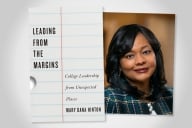You have /5 articles left.
Sign up for a free account or log in.
In A Problem of Fit: How the Complexity of College Pricing Hurts Students and Universities (University of Chicago Press), Phillip B. Levine explores just how confusing the college pricing system is to a typical student or parent. For example, more expensive colleges (in sticker price) may be less expensive for a student to enroll at than less expensive colleges (in sticker price) because of the aid offered at the more expensive institutions.
Levine, the Katharine Coman and A. Barton Hepburn Professor of Economics at Wellesley College, tackles the issues that confuse many people about tuition and financial aid. And he offers some solutions, such as the plan to double the Pell Grant (more on that below). He responded via email to questions about the book.
Q: How do you figure out how much it costs to go to college? You note lots of problems answering that question, so I’m not looking for a number. But how could you figure out what college costs, considering the range of public and private, two-year and four-year institutions? And the availability (at some of those institutions) of generous aid?
A: What students and their parents really need to know is what it will cost them to attend a particular college or university. The sticker price is irrelevant unless the student comes from a high-income family. The average “net price” (sticker price less grant-based financial aid) isn’t the actual cost they will pay unless they come from a family with “average” finances. The actual price they will pay at the various institutions they are considering can only be calculated accurately after factoring in financial aid that takes into account their own financial situation.
The best bet for families at the moment is to seek out net price calculators available on each institution’s website. They have significant limitations, as I detail in my book. They often are not simple to use, but they will report individualized cost estimates if you complete them. I should note that the nonprofit organization that I run (MyinTuition.org) provides simplified, individualized cost estimates for 73 colleges and universities.
Q: Why shouldn’t we just go for free community college to give people a start that would be free?
A: A fundamental premise of my book, as highlighted in the title, is that every student should attend an institution that is the best fit for them, regardless of their family’s financial situation. Community colleges provide outstanding opportunities for academically appropriate students. I strongly support policies designed to increase enrollment at community colleges among those students, particularly those who otherwise might not attend college at all. Free community college has that potential.
My concern is that students who would benefit more from attending four-year institutions would switch to enroll in a community college. Past evidence indicates that this may occur. A better policy would make pricing affordable for lower-income students at all institutions, allowing them the opportunity to choose the ones that would be the best fit for them. Subsidizing only one type of institution would interfere with that process.
Q: In the wake of COVID-19, we seem to be in a pattern of elite colleges (public and private) doing very well and most other colleges struggling. When you say the problem with complexity of college costs hurts colleges, how does it hurt the different types of colleges?
A: In my conversations with college and university administrators, they all worry that they are not getting all the students they want. Elite institutions would like to increase their socioeconomic diversity. All other institutions are also concerned about enrollment. Private four-year institutions worry about losing students to public four-year institutions. Four-year institutions worry about losing students to community colleges. And community colleges worry about losing students to no college. They all recognize that the problem of fit exists.
The entire point of reducing the complexity of college costs and finding ways to make it affordable for all students is to resolve this problem. Provide the tools and the means for students to attend the institutions where they will benefit the most. That must be our goal. That will help the students, their parents and colleges and universities.
Q: With our most expensive colleges now costing more than $75,000 a year (counting everything), should we focus on reducing their cost? Or more aid?
A: Indeed, the sticker price of college is a number that most people in the United States cannot afford. But few students pay those sticker prices. Those who are paying $75,000 or more to attend college likely come from families with incomes well over $200,000 per year. A focus on reducing sticker prices largely helps them.
The real pricing problem is that most institutions charge students from lower-income families too much. For a student from a family at the poverty line, a typical four-year public institution expects a cash payment of roughly $5,000 per year. How is that possible? This is a problem that needs to be addressed by expanding the availability of financial aid.
Q: Why do you support doubling the Pell Grant as a solution? Can it be adopted in today’s Congress?
A: Doubling the Pell Grant is the right solution to this problem because it provides exactly the right amount of support to those students who need it the most. It is available to students who attend both public and private institutions, and it does not disrupt the balance between them. And it comes at a relatively modest price tag. (The total Pell Grant budget in fiscal year 2021 is $29.5 billion.)
Improving social mobility is a goal that we all should support, and increasing access to college accomplishes that. In the past year, I have written several times about doubling the Pell Grant as the best approach to do so. Initially, I was never asked about its political fortunes. Now I am routinely asked about it. My impression is that the political dysfunction that pervades Washington these days leaves us all with a feeling of pessimism that we can implement solutions to improve the lives of everyday Americans. That may be true now, but it cannot be true forever. When the time comes, we need to be ready with effective policies. Doubling the Pell Grant is one of them.








